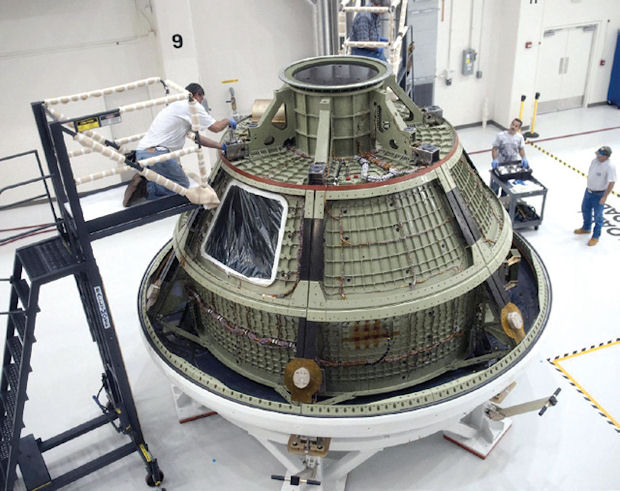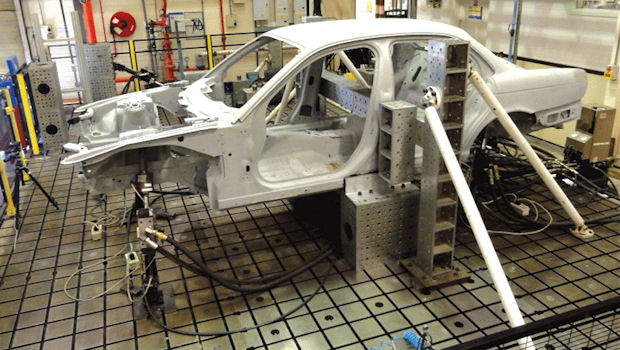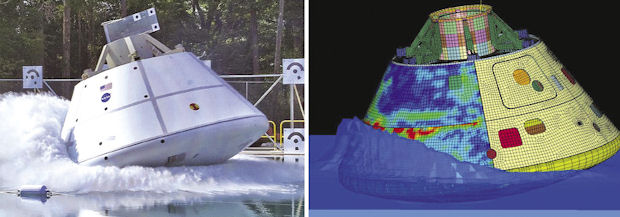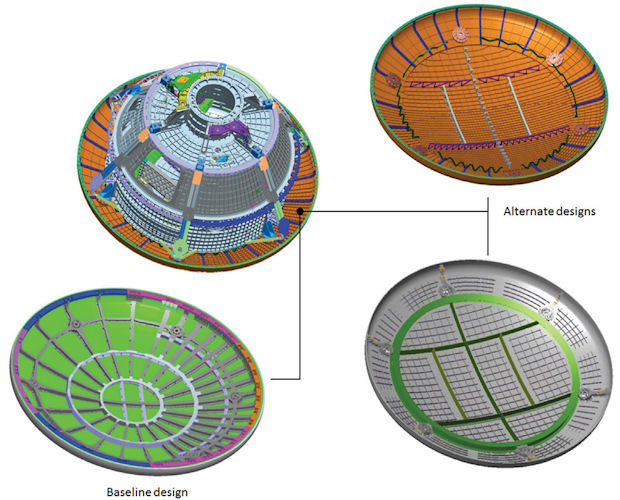
The Orion Ground Test Vehicle at NASA’s Kennedy Space Center. The circular heat shield is visible at the base of the vehicle. Image courtesy of NASA and Collier Research Corp.
Latest News
October 1, 2014
 A rig to test adhesive-bonded joints on an aluminum Jaguar body and compare results with predictions from nCode’s DesignLife software.
A rig to test adhesive-bonded joints on an aluminum Jaguar body and compare results with predictions from nCode’s DesignLife software.In February, President Obama announced the new Lightweight & Modern Metals Manufacturing Innovation Institute (LM3I), a consortium of universities, material providers and metal manufacturers whose mission is to help U.S. competitiveness and innovation in the areas of advanced lightweight and modern metals manufacturing. Trimming pounds from the nation’s cars, trucks and airplanes—thereby saving fuel and reducing pollution—is becoming a national, as well as commercial goal.
One of the simplest ways to trim weight from a product or structure is by substituting new, lighter materials, such as using aluminum in place of steel, for example. But when someone says “new materials,” many engineers’ minds go immediately to composites.
Composites is a broad term, encompassing everything from fiberglass to metal matrix composites, but we’re usually talking about carbon fiber (CF) composites, built from layers of CF cloth impregnated with resin. CF composites are stiff and heat-resistant. They possess an alluringly high strength-to-weight ratio. It’s even possible to design the material’s physical properties to some degree during production. By varying the number of layers and the relative orientations of the CFs themselves, you can make a composite structure stronger in the directions and locations your application requires.
CF composite use is mainstream in aerospace, where mechanical performance is at an extreme premium. But the aerospace industry has radically different manufacturing concerns than most industries—Boeing might make six or seven 787 Dreamliners this month, but Ford will have built about 65,000 F-150 trucks in that same time. How can composites hope to keep up? Sheet metal parts can be stamped out at the rate of hundreds per minute; CF composite parts can take hours, or even days to cure.
CF composites are also very costly, pound for pound—orders of magnitude more expensive than steel or aluminum. And, while accurate computer simulation is key to timely development of many products, composites (with their weird and varied failure modes) are notoriously difficult to simulate.
Do we have the maturity of material data and modeling tools to adequately predict CF composites’ behavior? Can the cost and manufacturability problems—especially cycle time—be solved anytime soon, or will CF composites remain a novelty?
Siding with Aluminum
If composites aren’t quite right for you, how about aluminum? Aluminum is certainly lighter than steel, albeit more expensive. Still, it’s much cheaper than CF composites. Unsurprisingly, aluminum is in the vanguard of lightweighting materials.
 The Orion Ground Test Vehicle at NASA’s Kennedy Space Center. The circular heat shield is visible at the base of the vehicle. Image courtesy of NASA and Collier Research Corp.
The Orion Ground Test Vehicle at NASA’s Kennedy Space Center. The circular heat shield is visible at the base of the vehicle. Image courtesy of NASA and Collier Research Corp.You’ve probably heard of Ford’s announcement to field an all-aluminum F-150 pickup truck next year (Editor’s note: Learn more with Ford Invests Heavily in Lightweighting Efforts). “All-aluminum” is a bit of an overstatement, but the truck will feature an aluminum cab and bed, which in itself is a fairly radical departure for an inherently conservative market segment. Altogether, Ford has shaved a third of a ton off the truck’s curb weight.
“The Ford F-150 announcement,” says John Weritz, The Aluminum Association’s VP of Standards and Technology, “is characteristic of where we see that industry going—using aluminum in applications where steel has been used before, to make lighter weight vehicles. That’s a bright spot in aluminum’s future. When you substitute aluminum for steel, you’re saving half the weight.”
 Orion Multi-Purpose Crew Vehicle splashdown test (left) and software simulation of loads on the vehicle (right). Images courtesy of NASA and Collier Research Corp.
Orion Multi-Purpose Crew Vehicle splashdown test (left) and software simulation of loads on the vehicle (right). Images courtesy of NASA and Collier Research Corp.Aluminum has been slowly gaining ground in the automotive industry for decades. Engines, once almost universally iron, are now almost universally aluminum. Radiators were once copper; they’re aluminum now. Aluminum auto bodies are hardly new, dating back to the late 1890s. Some Jaguars and Audis have aluminum bodies, as do Humvees. But while these are somewhat niche vehicles, the Ford F-150 is anything but: It’s been the most popular vehicle sold in America for more than three decades.
There is, of course, not just one kind of aluminum; new “recipes” are being developed all the time. Sixty years ago, there were 75 commercial alloys of aluminum. Today, there are more than 500, all of which are pretty hard to weld. This brings us to … steel.
 As the Orion crew module hits the water, high stress moves over the heat shield. The simulation is performed in LS-DYNA, then HyperSizer imports the internal loads at each dynamic millisecond time step. Image courtesy of NASA and Collier Research. Corp.
As the Orion crew module hits the water, high stress moves over the heat shield. The simulation is performed in LS-DYNA, then HyperSizer imports the internal loads at each dynamic millisecond time step. Image courtesy of NASA and Collier Research. Corp.Steely Intent
Steel is still the standard for a number of reasons. We were already working with steel on an industrial scale when Napoleon III’s dinner guests were marveling over his aluminum tableware. Steel is well understood; it’s easy to work with and it’s easy to join. And the steel industry isn’t about to roll over and die just yet. New steels, like new aluminums, are being developed all the time. (Editor’s note: See the author’s related articles online: deskeng.com/de/competing-with-composites and deskeng.com/de/engineering-the-future-of-steel.)
If steel is too heavy, what’s needed is lighter steel. That translates into stronger steel, and less of it. The new Ford F-150 sits on a frame of high-strength steel employing narrower gauges for a structure that’s 60 lbs. lighter, yet stiffer and stronger.
High-strength steels aren’t without their own problems, of course. They’re more expensive and generally harder to form. Cutting tools used to machine new, ultra-hard steels must themselves be made of expensive, exotic materials.
“You don’t get something for nothing,” quips Jon Aldred, director of product management at HBM-nCode. “If you’re trying to solve weight by going to high-strength steel, be aware that the fatigue behavior of a weld tends to be pretty unaffected by the grade [of steel being welded]. The heating and welding process tends to reduce the strength of that joint. Whether you have a mild steel or a high-strength steel, the strength of that weld is not much different. Without more expensive treatments on top, you don’t quite achieve the strength you thought you were going to achieve.”
Materials Joining
Aluminum is even more difficult to weld. “Jaguar got around that through the use of adhesives and the use of self-piercing rivets,” says Aldred. “We worked with them to simulate that, to assess the durability of these joints, and see where these rivets might be under too much load.”
Aluminum-to-aluminum is nowhere near as complicated as it gets, however. “One of the knock-on effects of trying to save weight—of trying to have the material you need in just the right place in the structure—is you may have aluminum at this end, steel at that end, and plastic in the middle,” Aldred explains, noting that one needs to consider the joining methodology: Rivets? Glue? Nuts and bolts? How well can your software simulate those joins?
Adding to the problem, says Manish Mehta, senior program manager at the National Center for Manufacturing Sciences (NCMS), “when you have carbon and aluminum hooked up to each other, it creates a galvanic cell. So now you’ve got to find ways to isolate these joints by creating exotic coatings. These things add cost and processing steps. Which suppliers have the technologies and capabilities for doing it?”
Downstream Consequences
There are many competencies that lightweighting forces on its practitioners, Mehta points out.
“It’s not about material substitution alone,” he adds. “You hear about aluminum becoming the basis for the new F-150 truck. There are major tooling changes and other domino effects on the industry that are yet to be felt. It completely tips the balance in the entire supply chain—all the way from procurement of raw materials, to processing of raw materials, to getting the supply base ready, to getting the training ready and tuning the production line to Six Sigma or better.”
 HyperSizer evaluated different structural concepts for the Orion heat shield carrier structure. The baseline composite skin with Titanium I stringers (left image, bottom) was evaluated against alternate metallic grid stiffened designs (right images, top and bottom). Image courtesy of NASA and Collier Research Corp.
HyperSizer evaluated different structural concepts for the Orion heat shield carrier structure. The baseline composite skin with Titanium I stringers (left image, bottom) was evaluated against alternate metallic grid stiffened designs (right images, top and bottom). Image courtesy of NASA and Collier Research Corp.And the new products may cause problems in places you didn’t expect. For example, Mehta says, the B pillars on certain vehicles are rumored to be so strong that it “takes a welding torch to extricate a driver from a car crash. There’s a movement out there to equip first responders with the right tools to deal with the cars on the road today.”
Spoiled for Choice
Designers are, as they say, spoiled for choice. In fact, the sheer number of materials available can be a bit daunting. Materials that are stiffness-driven, or dominated by the load in one direction are generally better candidates for CF composites. Structures that are loaded in two or more directions at the same time are probably better candidates for metal. Generally. Probably.
“You can’t really always know beforehand what material system is best for your application,” admits Craig Collier of Collier Research. “It has a lot to do with shape, and the loading of the structure.”
Your preconceived notions, he says, may be wrong: “We’ve seen that composites do bring down weight in many applications, but not in all applications.” He offers as an example his firm’s case study on NASA’s Orion spacecraft heat shield. When Collier’s HyperSizer software was used to explore the different material types, titanium turned out to be substantially lighter than carbon graphite composites.
Remember that new “aluminum” Ford F-150? One of its engine choices—the 2.7L EcoBoost V6—doesn’t have an aluminum block at all; it’s cast iron. Then again, it’s “new and improved” compacted-graphite-iron (CGI) iron, because even good ol’ cast iron isn’t holding still these days.
More Info
Subscribe to our FREE magazine, FREE email newsletters or both!
Latest News
About the Author
Mark ClarksonContributing Editor Mark Clarkson is Digital Engineering’s expert in visualization, computer animation, and graphics. His newest book is Photoshop Elements by Example. Visit him on the web at MarkClarkson.com or send e-mail about this article to DE-Editors@digitaleng.news.
Follow DE





